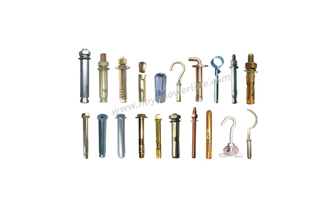Understanding the Distinction: J-Bolt vs. Anchor Bolt
When it comes to construction and engineering projects, fasteners play a crucial role in ensuring stability, strength, and reliability. Two common types of fasteners used in various applications are J-bolts and anchor bolts. While they may appear similar at first glance, there are significant differences between these two fasteners that can impact their suitability for specific purposes. In this comprehensive guide, we'll delve into the dissimilarities, functions, and best applications of J-bolts and anchor bolts.
1. J-Bolts: A Closer Look
J-bolts are named for their distinctive shape, which resembles the letter "J." These fasteners feature a curved or hook-like end, making them ideal for securing objects to concrete or other sturdy surfaces. The threaded portion of the J-bolt extends outwards, providing a convenient attachment point for nuts or other hardware.
Applications of J-Bolts
Due to their unique design, J-bolts find extensive use in a wide range of applications, including:
Structural Support: J-bolts are commonly employed in construction projects to anchor structural elements such as columns, beams, and walls to concrete foundations. The curved end of the bolt is embedded in the concrete, creating a secure connection.
Utility Pole Installation: J-bolts serve as a reliable fastening solution for securing utility poles into the ground. The curved section is embedded in the concrete footing, while the threaded portion provides a point of attachment for the pole.

Equipment Mounting: Many industries rely on J-bolts to mount heavy equipment and machinery securely. The bolts can be used to anchor equipment bases to concrete floors, ensuring stability and preventing movement.
2. Yipeng Anchor Bolts: Exploring their Functionality
Anchor bolts, on the other hand, are fasteners specifically designed for anchoring structures to concrete. Unlike J-bolts, anchor bolts have a straight, rod-like shape with a threaded end and a non-threaded, embedded portion. The non-threaded section is embedded in the concrete during installation, providing a solid foundation for secure attachment.
Common Uses of Anchor Bolts
Anchor bolts have diverse applications across several industries, including:
Building Construction: Anchor bolts are extensively used in the construction of buildings, bridges, and other structures to anchor steel columns, walls, and other load-bearing components to concrete foundations.
Industrial Machinery: Heavy machinery and equipment often require secure anchoring to prevent shifting or toppling during operation. Anchor bolts provide the necessary stability by fastening equipment to concrete surfaces.
Safety Barrier Installation: Anchor bolts play a vital role in securing safety barriers and guardrails along roads, highways, and industrial sites. These bolts ensure that the barriers remain in place, offering protection and preventing accidents.
3. Key Differences and Considerations
While J-bolts and anchor bolts may share some similarities in their usage, there are notable differences that dictate their respective applications. Here are a few crucial distinctions to keep in mind:
Design and Shape: J-bolts have a curved or hook-like end, whereas anchor bolts have a straight, rod-like shape with a threaded end. This distinction influences their installation and functionality
Attachment Method: J-bolts are attached by threading nuts onto the exposed threaded portion. In contrast, anchor bolts require embedding the non-threaded portion into the concrete, providing a secure anchor point.
Load-Bearing Capacity: Anchor bolts are designed to withstand heavy loads and resist tension forces. They offer superior strength and stability compared to J-bolts, which are better suited for lighter applications.
Versatility: While J-bolts are versatile and commonly used in various applications, anchor bolts excel in situations that demand exceptional structural integrity and load-bearing capabilities.
Conclusion
Understanding the difference between J-bolts and anchor bolts is crucial for selecting the appropriate fastener for your specific project requirements. J-bolts are suitable for lighter applications and provide a reliable attachment point, while anchor bolts offer robust strength and stability for heavy-duty projects. By choosing the right fastener, you can ensure the longevity, safety, and structural integrity of your construction or engineering endeavor.
More reading:
3 Basic Symbols Regarding Lifting Rigging Hardware
The Ultimate Guide to Turnbuckle Hardware



